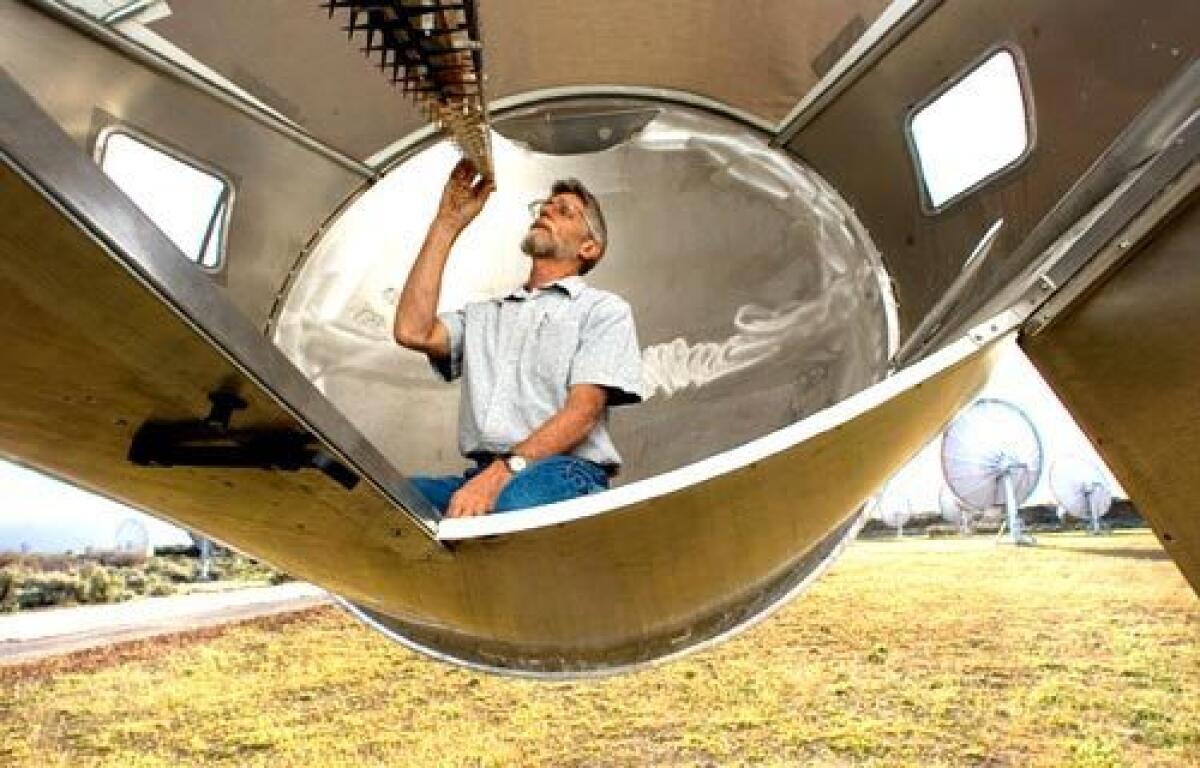Aliens get a new switchboard: a SETI radio telescope in Northern California

HAT CREEK, CALIF. — In this remote volcanic valley near Mt. Shasta, 42 telescope dishes have sprouted amid the soaring ponderosa pines, listening for a voice from space.
Every few seconds the 20-foot-wide dishes, scattered over dozens of acres, pirouette in perfect synchronicity, like dancers practicing their pas de deux before opening night.
Rick Forster, a slight, 59-year-old astronomer with the long beard of a man who has spent years in the solitude of the forest, said that after fine-tuning the dishes over the next few weeks to function as a single, giant ear, the real show will begin: listening for E.T.
The Hat Creek Radio Observatory will be the biggest radio telescope in the world specifically designed to search for extraterrestrial intelligence when the full 350-dish array is completed in the next few years.
“It’s nuts to think we’re alone,” said Forster. He works with the SETI Institute and UC Berkeley, which are jointly installing the array.
“It’s just a matter of looking in the right direction, at the right time, at the right frequency, with the right algorithm,” he said.
Over the last few decades, researchers for SETI (Search for Extraterrestrial Intelligence) have relied on borrowed telescope time to scan 1,000 stars for a signal from a technologically advanced culture.
The new array, funded by a $30-million gift from Microsoft Corp. co-founder Paul Allen, will enable researchers to search a million stars over 10 billion radio channels.
“The cosmic haystack is about to get enormously bigger,” said Jill Tarter, director of SETI’s research department.
She declined to estimate the odds that this new pitchfork will actually uncover an alien civilization. But she has a growing sense of excitement as the new telescope prepares to sweep the heavens for beeps and burps that could signal alien intelligence.
“It’s hard to imagine how stupendous it would feel to find something,” Tarter said in an interview at SETI’s Mountain View headquarters.
A plain-spoken woman with a shock of silver hair cut short, Tarter was the model for the Jodie Foster character of Ellie Arroway in the 1997 movie “Contact,” about the discovery of an alien broadcast. She has spent more than four decades -- her entire career -- trying to answer the are-we-alone question.
Now 64, she still hopes that, like Arroway, she will get her eureka moment. If humans do find something, everything we think we know about our place in the universe will be in for serious rewriting, she says. Human beings would no longer be creation’s crowning achievement. In fact, we might not even make honorable mention.
“If we find a second technological civilization, we will know there are many,” Tarter said. Earth would be transformed from an outpost to just another commuter station on a nearly infinite railroad line.
But Tarter is trying to keep her expectations low.
“It’s also possible we are unique,” she said.
The middle of nowhere
Hat Creek is one of those places you’d never stumble on. It’s 30 miles from the closest community -- Shingletown, an assemblage of castaway shops centered on a rollicking bar and restaurant along the highway that’s crowded with enthusiastic imbibers at midday.
“There ain’t a lot of culture,” Forster said.
What makes this place a challenge for human beings, however, makes it nearly perfect for radio telescopy.
To operate effectively, a radio telescope must be far from civilization, which produces abundant interference from television, radio and cellphones. At 3,500 feet above sea level, Hat Creek is also surrounded by volcanic peaks containing enough magnesium to absorb any man-made radio broadcasts that otherwise might wander in.
Forster loves it, but he also has a sense of humor about it. The welcome mat outside his office depicts an alien’s bulbous head and headlamp eyes. “Welcome all species,” it reads.
To catch a signal from an alien race, you either have to build an enormous dish, like the 1,000-foot-diameter Arecibo facility in Puerto Rico, or connect many smaller dishes together, like New Mexico’s Very Large Array, which has 27 dishes, each 82 feet across.
At Hat Creek, computers will combine data from its 350 dishes to produce, in effect, one giant telescope. “What we’re doing is creating a big dish, 90 acres across,” Forster said.
Even with this level of technology, the SETI scientists acknowledge it’s a quixotic quest.
On a recent afternoon, senior astronomer Seth Shostak, 64, was showing a visitor around SETI’s headquarters when a harried-looking white-haired man rushed by.
“This is Frank Drake,” Shostak said reverentially.
The stocky, distracted man extended his meaty hand, shook quickly and sped off, a little like the White Rabbit from “Alice in Wonderland.”
Drake disappeared down the rabbit hole of alien research decades ago. He not only mounted what many people count as the first serious experiment to search for aliens, he also created the landmark Drake Equation, a set of mathematical assumptions that attempts to predict how many advanced civilizations might exist in the Milky Way galaxy.
The equation is N = R* x fp x ne x fe x fi x fc x L. It says that the number of civilizations we might communicate with (denoted by N) equals the rate of star formation (R*) multiplied by the fraction of stars that have planets (fp) multiplied by the average number of planets around a star that can support life (ne) multiplied by the number of those planets that actually develop life (fe) multiplied by the fraction that develop intelligent life (fi) multiplied by the fraction that develop technology that can be detected from Earth (fc).
All this is then multiplied by the length of time a technological civilization can exist (L). Remember, our world entered the broadcast age only a century ago, and has already come close at least once -- the Cuban missile crisis -- to snuffing itself out.
Some researchers have suggested that the answer could be up to 1 million alien civilizations in the Milky Way. Drake’s solution? Ten thousand alien civilizations, in a galaxy of 100 billion stars.
‘Can it be this easy?’
Drake made his first attempt to find Earth’s sister planet in 1960, using an 85-foot-diameter antenna at the National Radio Astronomy Observatory in West Virginia. Radio waves have long been considered ideal for communication with alien civilizations because the waves are easy to produce and receive, which is why we use them on Earth to carry television and radio signals. They also penetrate the gas and dust between stars.
Drake pointed the antenna at two nearby stars, Epsilon Eridani and Tau Ceti -- virtually next-door neighbors in galactic terms at just over 10 light-years from Earth.
In April 1960, Drake picked up a signal. His first thought, according to Shostak, was: “Can it be this easy?”
The second was, “Holy cow, what do I do now?”
“It wasn’t that easy,” said Shostak, who is writing a book about the search for alien intelligence.
Drake, now 78, had mistaken a passing aircraft for an alien broadcast. It was the first of many false alarms to haunt the field, presenting a problem that persists today: separating the man-made and natural radio signals from the electronic “Howdy, neighbor” of an alien civilization.
Shostak calls it the “E.T. or AT&T?” problem.
So how does one go about tuning in intergalactic radio? It’s a lot more complicated than simply pointing your antenna at the right star, just as tuning in your favorite radio station on Earth requires more than being within broadcast range. You have to spin the dial.
The radio spectrum ranges over frequencies of 3 kilohertz (3,000 hertz) to 300 gigahertz (300 billion hertz). The alien version of “I Love Lucy” could be hiding anywhere in between.
With the Hat Creek array, SETI will be able to scan a much broader range than ever before: everything from 0.5 gigahertz to 11 gigahertz, a range of 10 billion channels.
When researchers get a promising signal, the real work begins.
The key test, according to Tarter, is the bandwidth. Nothing in nature produces signals narrower than 300 hertz.
“Quasars, pulsars, things like that make signals much broader,” Shostak said. “A narrow signal must have been produced by a transmitter.”
But whose? Ours or theirs?
Redefining patience
The next step after finding a signal is to watch it for a while. Does it change, or does it sit there on the dial giving off a continuous whine or beeping as regularly as a metronome? An alien signal would undergo subtle changes as Earth’s orbital position changed relative to the other planet, whereas a man-made signal would be constant.
“Getting a signal is not such a big deal,” Shostak said. “At Arecibo, we got one every six seconds.”
With the Hat Creek array, he expects to get a promising signal every couple of hours. Every six months, he expects, researchers will get one that seems to pass all the tests. But that’s just the beginning. After that, SETI will alert other observatories for confirmation.
Over nearly 40 years of searching, no signal has panned out to be anything more than a satellite transmission or some mundane natural pulse.
But the time period is deceptive. All the actual search time added together amounts to only 18 months of concerted effort, Shostak said -- hardly enough to conclude that our galactic brethren either are not there or are not interested in communicating.
For the truly dedicated, patience is not only a virtue but a requirement. Just ask Tarter.
She began her search in the late 1970s at NASA’s Ames Research Center in the Bay Area, where scientists were interested in following up on Drake’s work.
Tarter signed on. “I realized I was alive in the first generation of human beings who could answer the are-we-alone question rather than going around asking priests and philosophers,” she said. “Good grief, why wouldn’t I want to become involved in that?”
The NASA search was killed by Congress in 1993, but Tarter refused to give up.
On the Monday after the program’s demise, she phoned telescope operators around the world and asked if she could still have telescope time if she could come up with the money. Sure, they said, figuring there was little chance.
They were wrong. The project was transferred to the SETI Institute, which has been heading up the work for the last 15 years.
Tarter’s tenacity was hard-won. Toughened by the experience of losing her father at 12 -- she still describes him as the sun in her solar system -- Tarter was undeterred by school counselors who asked why she wanted to take calculus since she was just going to “have babies.” She earned degrees in engineering and astronomy.
At a meeting of women scientists, she found similar stories. “Their father was the center of their world and he died when they were young. That left us a bit more stubborn,” she said.
“I told Carl that story,” she said, laughing. The Carl she referred to was Carl Sagan, the famed astronomer behind the 1980 television series “Cosmos.”
Sagan resurrected Tarter’s story in his novel “Contact,” on which the movie was based. The story ends after astronomer Ellie Arroway journeys to a far-off planet and has a transcendent encounter with what appears to be her dead father.
“That’s pure Carl,” Tarter said. “He used to say he wished he could have one more conversation with his father.”
Tarter’s tenacity is being challenged one more time. Installing the 42 dishes thus far placed at Hat Creek used up the gift from Microsoft’s Allen. It will take $40 million more to complete the 350-dish array.
One fundraising plan, called Adopt a Scientist, offers select donors dinner with Tarter and her husband at their Berkeley home, followed by a flight to Hat Creek, where donors can spend the night on the site.
It will take a lot of dinners to complete the array, but Shostak believes time and technology are on their side.
“We’ve only begun to fight,” he said. “If this experiment has merit, we should succeed within a generation.”






